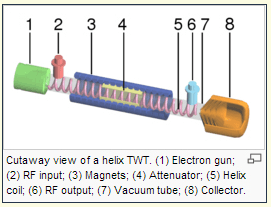TWT
A traveling-wave tube (TWT) is a specialized vacuum tube used to amplify radio frequency (RF) signals to high power, usually as part of an electronic assembly known as a traveling-wave tube amplifier (TWTA).
The bandwidth of a broadband TWT can be as high as one octave, although tuned (narrowband) versions exist, and operating frequencies range from 300 MHz to 50 GHz. The power gain of the tube is on the order of 70 decibels.
The device is an elongated vacuum tube with an electron gun (a heated cathode that emits electrons) at one end. A magnetic containment field around the tube focuses the electrons into a beam, which then passes down the middle of an RF circuit (wire helix or coupled cavity) that stretches from the RF input to the RF output, the electron beam finally striking a collector at the other end. A directional coupler, usually a waveguide or an electromagnetic coil, fed with the low-powered radio signal that is to be amplified, is positioned near the emitter, and induces a current into the helix.
The RF circuit acts as a delay line, in which the RF signal travels at near the same speed along the tube as the electron beam. The electromagnetic field due to the RF signal in the RF circuit interacts with the electron beam, causing bunching of the electrons (an effect called velocity modulation), and the electromagnetic field due to the beam current then induces more current back into the RF circuit (i.e. the current builds up and thus is amplified as it passes down).
A second directional coupler, positioned near the collector, receives an amplified version of the input signal from the far end of the RF circuit. Attenuators placed along the RF circuit prevent the reflected wave from traveling back to the cathode.
References
- 1997 Industrial Assessment of the Microwave Power Tube Industry - US Department of Defense
- Gilmour, A. S. (1994). Principles of traveling wave tubes. Artech House Radar Library. Boston: Artech House..
- Shulim E. Tsimring (2007). Electron beams and microwave vacuum electronics. John Wiley and Sons.
- Kompfner, Rudolf (1964). The Invention of the Traveling-Wave Tube. San Francisco Press.
- Pierce, John R. (1950). Traveling-Wave Tubes. D. van Nostrand Co.
- TWT - Travelling Wave Tubes. albacom.co.uk
- Zimmerman, Robert (Fall 2000). "TELSTAR". Invention and Technology Magazine, American Heritage.
- Pond, Norman H. (2008). The Tube Guys. West Plains, Missouri: Russ Cochran.
- John Everett (1992). Vsats: Very Small Aperture Terminals. IET.
- Dennis Roddy (2006). Satellite Communications. McGraw-Hill Professional.
- L. Sivan (1994). Microwave Tube Transmitters. Springer.
- Henry W. Cole (1985). Understanding Radar. Collins.
- (Extracted from Wikipedia.com.)

